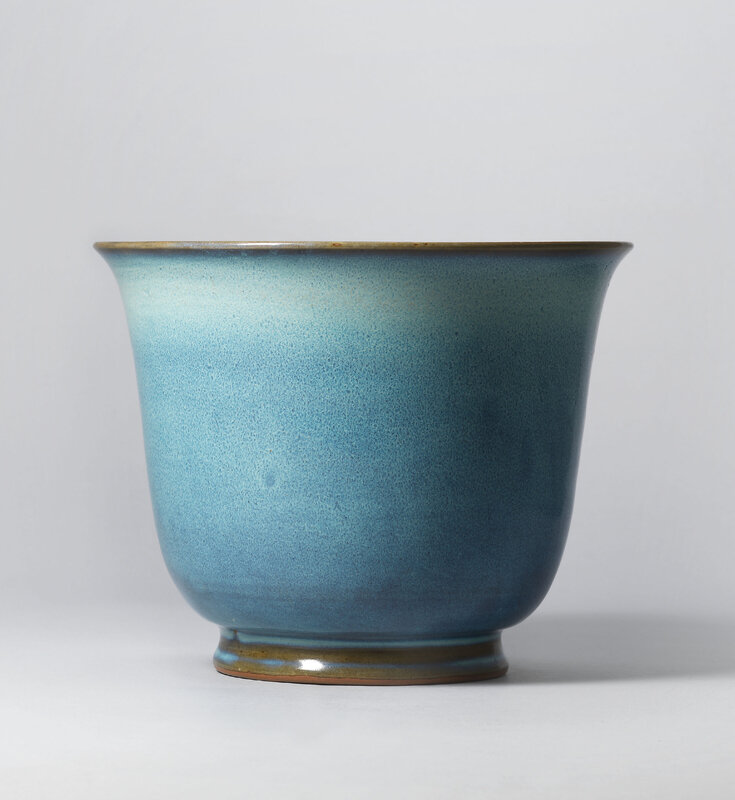Christie's. Beyond Compare: A Thousand Years of the Literati Aesthetic (Evening Sale), Hong Kong, 26 November 2018
An important and extremely rare jun 'number four' jardiniere, Yuan-early Ming dynasty, 14th-15th century
.jpg)
.jpg)
.jpg)
Lot 8021. An important and extremely rare Jun 'number four' jardiniere, Yuan-early Ming dynasty, 14th-15th century; 10 in. (25.4 cm.) wide. Estimate: HK$30,000,000.00 - HK$50,000,000.00 (USD 3,845,250 - USD 6,408,750). Unsold. © Christie's Image Ltd 2018.
The jardinière is of a deep inverted bell form, and covered overall with a thick and finely flecked lavender-blue glaze shading to brown at the rim and foot. The base is pierced with five drainage holes, and covered with a wash of light greenish-brown, with an incised numeral si, ‘four’.
Provenance: Sold at Sotheby’s Hong Kong, 17 November 1975, lot 5.
Literature: Idemitsu Museum of Arts, The 15th Anniversary Catalogue, Tokyo, 1981, no. 693
Note: With their bold forms, sophisticated glazes and innovative use of colour, Jun wares are some of the most striking ceramics of the Song, Jin and Yuan periods. They rarely have any surface decoration, but rely for their impact on a remarkable glaze which is thick, opalescent and appears in various tones of blue. The Jun glaze is of lime-alkali type, but its particular qualities have been the subject of much research. The opalescence and much of the blue appearance of the glaze are caused by several in-glaze phenomena, the most important of which is liquid-liquid phase separation - the formation of tiny globules of lime-rich glass within the silica-rich glaze matrix. To produce this emulsion, the Jun glaze had to be kept at a high temperature for a significant period and had to be cooled very slowly. The typical northern Chinese mantou or bread-bun kiln was ideal for firing this type of glaze, since it had excellent insulation.
The present jardinière belongs to a rare group of Jun vessels comprising narcissus bowls, flower pots, and zun-shaped vases, where each vessel has been incised or stamped with a Chinese numeral on the base. The numbers range from one to ten, and judging from the examples in museums and those examined from the excavations at Juntai, Yuxian, the numbers relate to the size of the vessels - ten representing the smallest size and one the largest. A significant number of these numbered vessels have survived in palace collections and Jun ware bulb bowls, plant pots and plant pot stands of different forms can be seen in various court paintings of Ming and Qing dynasties, such as in Eighteen Scholars: Chess (fig. 2), where a similar jardinière containing calamus roots is depicted in the right foreground, and in Twelve Beauties: Looking in a Mirror (fig. 3), where a mallow-form jardinière is placed on the windowsill.
The present jardinière is the only example of this rare form bearing the numeral si, ‘four’. Other jardinières of this form are found with different numerals, these include three in the National Palace Museum, Taipei, variously incised with numerals ‘one’, ‘eight’, ‘nine’, and illustrated in A Panorama of Ceramics in the Collection of the National Palace Museum: Chün Ware, Taipei, 1999, nos. 17, 18, 19, respectively; one in the Avery Brundage Collection in the Asian Art Museum of San Francisco, incised with numeral ‘two’, illustrated in Chinese Ceramics: A New Comprehensive Survey, New York, 1996, no. 237; and a further example also incised with numeral ‘two’ from the collections of J. T. Tai Foundation and Leshantang, last sold at Sotheby’s Hong Kong, 11 April 2008, lot 2508. Compared to this shape, there seems to be a greater number of known Jun jardinères in mallow form, these include one with a matching stand with numeral ‘three’ in the Tianjin Museum, illustrated in Tianjin shi yishu bowuguan cangci, Hong Kong, 1993, no. 37; another with numeral ‘nine’, also with matching stand, sold at Christie’s Hong Kong, 30 May 2012, lot 3976.

/https%3A%2F%2Fprofilepics.canalblog.com%2Fprofilepics%2F1%2F0%2F100183.jpg)
/https%3A%2F%2Fstorage.canalblog.com%2F03%2F02%2F119589%2F96711876_o.jpg)
/https%3A%2F%2Fstorage.canalblog.com%2F11%2F31%2F119589%2F94773502_o.jpg)
/https%3A%2F%2Fstorage.canalblog.com%2F20%2F83%2F119589%2F94772815_o.jpg)
/https%3A%2F%2Fstorage.canalblog.com%2F26%2F72%2F119589%2F75604929_o.jpg)
/https%3A%2F%2Fstorage.canalblog.com%2F59%2F60%2F119589%2F26458628_o.jpg)




/image%2F1371349%2F20240418%2Fob_ac5c4c_telechargement.jpg)
/image%2F1371349%2F20240418%2Fob_709b64_304-1.jpg)
/image%2F1371349%2F20240418%2Fob_22f67e_303-1.jpg)
/image%2F1371349%2F20240417%2Fob_9708e8_telechargement.jpg)